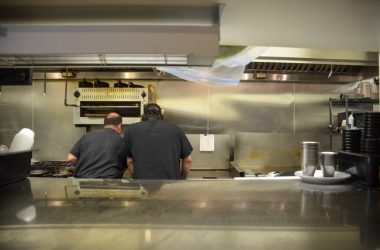The City of Salem Ben Maxwell collection notes that (photo #754):
This photo of the Jason Lee House was taken c.1960 when it was being boarded up and prepared for a move to a temporary site on Front Street in Salem, Oregon. The wing and chimneys, porches and doorways have been removed but some of the windows still have the glass panes in. It was later moved again to its present location as part of the Mission Mill Complex in Salem. Jason Lee (1803-1845), Canadian-born and Massachusetts educated, was a missionary and pioneer leader in the Salem area in the 1840’s. This was the simple home they constructed in 1841 on Mill Creek where the missionaries had a water-powered lumber & grist mill.

While the current caption notes that this photo was taken in 1960, this date does not appear to be accurate. While many of the general facts are correct, the caption also fails to acknowledge the efforts of the Marion County Historical Society. The Marion County Historical Society had a history of working to save Salem’s oldest structures from demolition, originally fighting to preserve the Parsonage building in 1953 when it was located at 1335 Ferry Street and offered by the school district to the historical society for free, provided they could move it off this property.
In fact, the Society had originally hoped to create a museum on the original site of the Jason Lee House. On Nov. 7, 1961, the Oregon Statesman reported that the Marion County Historical Society voted to authorize its board to negotiate an option on the property at 960 Broadway St. N.E., the location of the Jason Lee House, in order to move the Methodist Parsonage to the site as part of a proposed new Jason Lee Historic Center.
Clarence Townsend, the owner of the Lee House had offered the property on Broadway up for sale earlier that year. The Marion County Historical Society hoped to make an offer on the property and relocate the Parsonage here, which had been temporarily stored at the Thomas Kay Mill site since 1953.
Unfortunately, the Oregon Statesman reported on April 3, 1962: “The society had hoped to purchase historically valuable property at Broadway and Liberty Streets NE, but this property was sold last week to a group of Salem businessmen. It contains the original Jason Lee House…We were very disappointed, said (Hugh) Morrow, that we were not informed of the higher offer for the Broadway site and given a chance to at least match it.”
The new owners informed the Marion County Historical Society that they could have the Jason Lee House for free, but it would need to be moved off the Broadway site by March 1, 1963, in order to make way for redevelopment of the site.
There had been earlier efforts to acquire and preserve the Jason Lee House. In 1941 Attorney General I.J. Van Winkle drew up a bill to purchase the Jason Lee house and grounds for $23,000. Unfortunately, this bill never made it out of committee to be considered by the larger Oregon Legislature. In 1946, the Salem Chamber of Commerce went on record in favor of preserving the Jason Lee house as a historical site, as the oldest structure in Salem.
In 1963, the Salem City Council considered supporting the Marion County Historical Society’s efforts to preserve both buildings by relocating them at a Salem city park. They considered proposals to move both the Jason Lee House and the Parsonage to either Bush’s Pasture Park or Marion Square Park. As part of their larger efforts to educate the public about the historical significance of the Jason Lee House, the Marion County Historical Society even offered the public an opportunity to tour the house on Feb. 10, 1963, before the City Council made their final decision. Lewis Judson, a member of the Marion County Historical Society, whose grandfather was a carpenter in charge of constructing the Lee House, was part of the group who offered the public tours of the Jason Lee House, while it was still in its original location on Broadway Street.
Floyd McKay, of the Oregon Statesman, wrote about the City Council’s options in his Feb. 17, 1963, Oregon Statesman Article: “Council will Decide Fate of Weatherbeaten, 123-year-old Jason Lee House.” Floyd clarified that Salem’s Mayor even had a historical connection to the house through Judge Ruben Boise, who had occupied this house from the 1880 through 1907. It turns out that Judge Boise was an ancestor of Mrs. Willard Marshall, the Mayor’s wife.
A special three councilmember committee initially recommended that the Salem City Council authorize the Jason Lee House be placed in Bush’s Pasture Park near the Bush House. A second option the Salem City Council considered was Marion Square Park, which the Salem Parks Advisory Commission had voted to recommend for the site for both the house and the Parsonage.
The full council had serious concerns about the financial obligations for restoring both houses and did not approve the placement of the historical buildings in either Bush’s Pasture Park or Marion Square Park. Instead, the Council referred the matter to a joint Committee for the Siting of the Jason Lee House and Methodist Parsonage comprised of representatives from the Salem Planning Commission and Salem Parks Advisory Board.
Despite this delay in determining the final location for the house, the Marion County Historical Society was still responsible for complying with the owner’s requirements to move the Jason Lee House off the Broadway property before March 1, 1963. The Capitol Journal published several photos of the Jason Lee House being prepared to be moved to a temporary location at 660 Front Street N.E. on Feb. 20 and Feb. 28, 1963.
The house was set to be moved on March 6, 1963, however there was a delay due to a city ordinance prohibiting moving wooden structures into Fire Zone 1. The city granted a temporary variance, and the Jason Lee House was actually moved on March 7, 1963, with photos of the move published in the Oregon Statesman. Therefore, with these facts confirmed, the date of the photo caption will be corrected from 1960 to 1963.
The siting committee were originally expected to provide their final recommendations about the siting of the Jason Lee House and Parsonage in June 1963. However, they requested a 3-month extension, until September 1963.
That summer, the Committee considered a report, “Mill Place on the Willamette” about the two structures, completed by Elizabeth Walton, who was then a graduate student at the University of Delaware. Her report provided not only a comprehensive history of the significance of these two structures, but also an estimate of the costs for restoration and the benefits of their use as part of a historical interpretive complex to educate the public about our heritage.
A total of 13 sites were investigated, including the Mill property, Marion Square Park, the Lee Mission Cemetery, Willson Park, the Willamette University campus and the state fairgrounds. The Committee’s first choice was the Thomas Kay Woolen Mill property, with their second choice the 2-acre Lee Mission Cemetery site. A second extension was requested to temporarily store the Jason Lee House at the Front Street location through the summer of 1965, so that the Marion County Historical Society could move forward with organizing the new Mission and Mill Museum nonprofit organization.
The building was moved from its Front Street location to the mill property on July 22, 1965, and the Salem City Council waived the usual moving fee to permit the Mission Mill Museum Corp to move the Jason Lee House to the mill property. The buildings were moved to the woolen mill property at 12th and Mission, where the buildings would be restored as part of a larger historical park to be known as Thomas Kay Historical Park. Plans for restoration of the Jason Lee house were drawn up by Salem architect, Charles Hawkes. Groundbreaking ceremonies for the siting of the Jason Lee House were held in June 1965.
The City of Salem collaborated with the private property owner as well as several other project partners to complete an archaeological project on this site in May 2020 and were able to uncover a number of interesting artifacts from the early missionary period.
To learn more and see the restored Jason Lee House, please visit the Willamette Heritage Center and take their Houses Tour. You can also visit 960 Broadway Street N.E. and see the interpretive panel in the location where this house originally stood, including bricks from the foundation that were recovered.
The Ben Maxwell Collection consists of more than 5000 photographs donated to the Salem Public Library by the estate of Mr. Ben Maxwell, a noted Salem photographer and historian who died in 1967. Maxwell was a native of Salem, where he was born in 1898. He attended college at Oregon State University where he studied history and journalism. He started working with the Capital Journal newspaper in 1939. Because he packed his camera on every quest for historical stories, he was able to illustrate his articles for readers of the Capital Journal, the Oregon Journal, the Oregonian, and several magazines.
He recorded on film at least 13 governors, old-timers now gone, covered bridges now missing, and buildings and homes no longer standing. The collection includes copies of rare early Oregon photographs taken by others which have in turn been copied over and over by later researchers and feature story writers. This collection is a work in progress and many additional photographs remain to be scanned. The collection can be accessed at: https://photos.salemhistory.net/digital/collection/max
The City of Salem’s Historic Preservation Program staff within the Community Development Department in collaboration with the Salem Historic Landmarks Commission are in the process of completing an inventory of this collection and working to confirm and verify the content and narratives associated with all the photographs in this collection. Please contact Salem’s Historic Preservation Officer, Kimberli Fitzgerald at [email protected] with any suggestions, historic facts, or questions you might have about these historic photos.
STORY TIP OR IDEA? Send an email to Salem Reporter’s news team: [email protected].
SUPPORT OUR WORK – We depend on subscribers for resources to report on Salem with care and depth, fairness and accuracy. Subscribe today to get our daily newsletters and more. Click I want to subscribe!
Kimberli Fitzgerald is the city of Salem's archeologist and historic preservation officer. She is a regular contributor to Salem Reporter's local history column.









